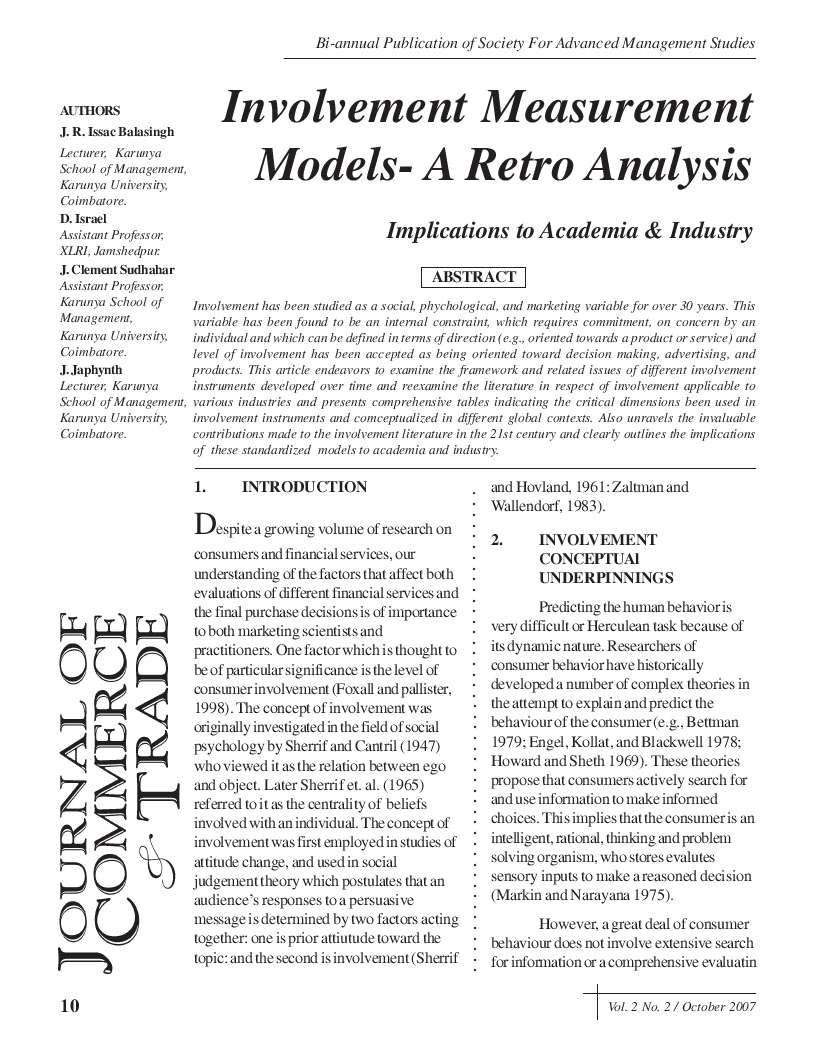Involvement Measurement Models-A Retro Analysis
Implications to Academia and Industry
Keywords:
Involvement Measurement Models, Inventory Model, ProfitabilityAbstract
Involvement has been studied as a social, phychological, and marketing variable for over 30 years. This variable has been found to be an internal constraint, which requires commitment, on concern by an individual and which can be defined in terms of direction (e.g., oriented towards a product or service) and level of involvement has been accepted as being oriented toward decision making, advertising, and products. This article endeavors to examine the framework and related issues of different involvement instruments developed over time and reexamine the literature in respect of involvement applicable to various industries and presents comprehensive tables indicating the critical dimensions been used in involvement instruments and comceptualized in different global contexts. Also unravels the invaluable contributions made to the involvement literature in the 21st century and clearly outlines the implications of these standardized models to academia and industry.
Downloads
References
Abdullah H. Aldlaigan and Francis A. Buttle - University of Manchester; “ Consumer Involvement in financial Services: An Empirical Test of Two Measures”, The international Journal of Bank Marketing: 2001; 19, 6; ABI/ INFORM Global: pg 232-245.
Arora R. (1982), “Validation of an S-O-R model for situation, enduring, and response components of involvement”, Journal of Marketing Research, Vol. 19 NO. 11, pp. 505-16.
Banwari Mittal, Northern Kentucky University; “ A Comparative Analysis of Four Scales of Consumer Involvement”, Psychology & Marketing (1986 -1998): Oct. 1995; 12,7; ABI/INFORM Global Pg. 663-682.
Banwari Mittal, B. (1989), “ A theroretical analysis of two recent measures of involvement”, in Srull, T.K. (Ed.), Advances in Consumer Research, Association for Consumer Research, Vol. 16, pp. 697-702.
Bettman, James R. (1979), An Information Processing Theory of Consumer Choice, Reading, M.A: Addison - Wesley.
Bloc, P.H. and Pichins, M.L. (1983), “A theroretical model for the study of product importance perceptions”, Journal of Marketing. Vol. 47 No. 3, pp. 69-81.
Bloch, P.H. and Richins, L.M. (1983), “A theoretical model for the study of product importance perceptions”, Journal of Marketing. Vol. 47 No. 3, pp. 69-81.
Clarke, Keith and Russell W. Belk (1987), “The effects of Product Involvement and Task Definition On Anticipated Consumer Effort,” in Advances In Consumer Research, Vol. 5, ed. H. Keith Hunt, Ann Arbor, MI: Association for Consumer Research, 313-318.
David J. Good; “Utilizing Consumer Involvement to Market Services”, Review of Business Spring 1990; pg. 3-6.
Engel, J.F., Kollat, D.T. and Blackwell, R.D. (1978), Consumer Behavior, Dryden Press, New York, NY.
Engel, James F., and Roger D. Blackwell (1982), Consumer Behavior, Dryden Press, New York, NY.
Gordon R. Foxball and John G. Pallister (1998) Measuring purchase decision involvement for financial services: comparision of the Zaichkowsky and Mittal Scales, International Journal of Bank Marketing 16/5, 180-194.
Houston, M.J. and Rothchild, M.L. (1978), “conceptual and methodological perspectives in involvement”, in Jain S.C. (Ed.), Research Frontiers in Marketing Association, Chicago, IL, pp. 187-7.
Howard, J.A. and Sheth, J.N. (1969), The theory of Buyer Behavior, John Wiley, New York, NY.
Hupfer, Nancy and David Gardner (1971), “Differential Involvement with Products and Issues; An Exploratory Study,” in Proceedings: Association for Consumer Research, ed. David M. Gardner, College park, MD: Association for Consumer Research, 262-269.
Jean-Noël Kapferer and Gilles Laurent; “Consumer Involvement Profiles: A New practical Approach to Consumer Involvement” pg. 48-56.
Judith Lyne Zaichkowsky-Simon Fraser University, “ The Emotional Aspect of Product Involvement” (1987), pg. 32-35.
Judith Lyne Zaichkowsky; “Measuring the involvement Construct”, Journal of Consumer Research (pre-1986); Dec. 1985; 12,3; ABI/INFORM Global pg. 341.
Kassarjian, H. H. (1981), “Low involvement: a second look”, Advances in Consumer Research, Vol. 8, pp. 31-4.
Krugman, H.E. (1962), “An Applicaiton of Learning Theory to TV Coot Testing,” Public Opinion Quarterly, Vol - 26 (Winter), pp. 626-634.
Krugman, H.E. (1965), “The impact of television advertising; learning without involvement”, Public Opinion quarterly, Vol. 29 (Winter), pp. 349-56.
Krugman, H.E. (1967), “The Measurement of television advertising involvement”, Public Opinion quarterly, Vol. 30, pp. 583-96.
Krugman, H.E. (1977), “Memory withour Recall, Exposure Without Perception,” Journal of Advertising Research, 17 (August), 7-12.
Markin, Rom J. and Chem Narayana (1975), “Behavior Control: Are Consumers Beyond Freedom and Diginity ?” in Advances in Consumer Research, Vol. 3, ed. Beverlee B. Anderson, Ann Arbor, MI: Association for Consumer Research, 222-228.
Olshavsky, Richard W. and Donald H. Granbois (1979), “Consumer Decision Making-Fact or Fiction?” Journal of Consumer Research, 6 (Sep.) 93-100.
Park, C. Whan and S. Mark Young (1983), “Types and Levels of Involvement and Brand Attitude Formation,” in Advances in Consumer Research, Vol. 10, eds. Richard Bagozzi and Alice Tybout, Ann Arbor, MI: Association for Consumer Research, 320-324.
Park, C. Whan and S. Mark Young (1986), “Consumer Response to Television Commercials: The Impact of Involvement and Background Music on Brand Attitude Formation, “Journal of Marketing Research, 23 (February), 11-24.
Rickard L. Celsi and Jerry C. Olson (Sep. 1988); “The Role of Involvement in Attention and Comprehension Processes”, Journal of Consumer Research, pg. 210.
Rotkhschild, M.L. (1984), “Perspective on involvement: current problems and future directions”, in Kinnear, T.C. (Ed.), Advances In consumer Research, Association for Consumer Research, Vol. 11.
Sherif, M, and Cantril, H. (1947), The psychology of Ego-involvement: social Attitudes and Identification, John Wiley and Sons, New York, NY.
Sherif, M. Sherif, C.W. and Nebergall, R.E. (1965), Attitude and Attitude Change: the social Judgement-involvement Approach, W.B. Saunders Co., London.
Zaichkowsky and Judith Lynne; “The personal Involvement Inventory: Reduction, Revision, and Application to Advertising”, Journal of Advertising; Dec. 1994; 23,4; ABI/INFORM Global pg. 59-70.
Zaichkowsky and Mittal Scales; “Measuring purchase decision for financial Services”: pg. 1-13.
Zaltman, G. and Wallendorf, M. (1983), Consumer Behaviour: Basic Findings and Management Implications, John Wiley and Sons, New York, NY.

Downloads
Published
Issue
Section
License
Copyright (c) 2007 J. R. Issac Balasingh, D. Israel, J. Clement Sudhahar, J. Japhynth

This work is licensed under a Creative Commons Attribution 4.0 International License.










